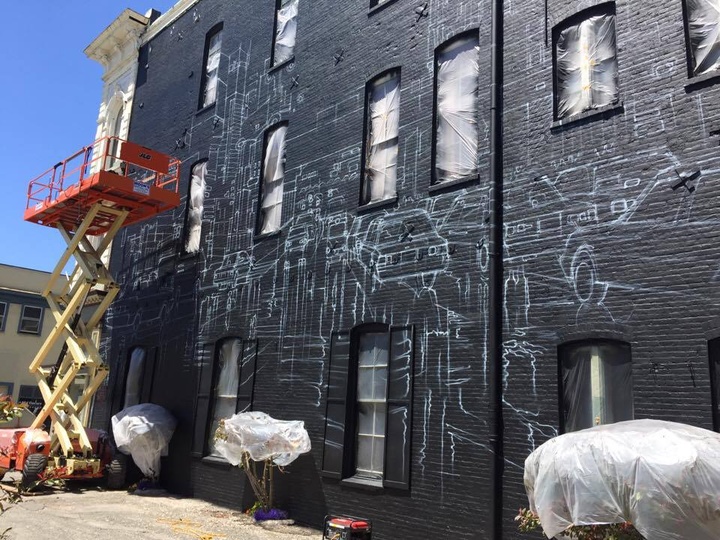
A foreigner painting something that’s not Eureka on a building in Eureka. | Ryan Burns
In 1933, Nelson Rockefeller commissioned Diego Rivera to paint a mural at Rockefeller Center under the theme “Man at the Crossroads Looking with Hope and High Vision to the Choosing of a New and Better Future.” Among the many figures Rivera chose to paint was Vladimir Lenin, holding hands with workers from around the world. Rockefeller was so alarmed that he had the mural destroyed. Rivera managed to get away with a few photographs of it so that he could later re-create it in Mexico.
E.B. White wrote a poem for the New Yorker about the controversy called “I Paint What I See: A Ballad of Artistic Integrity.” It begins:
‘What do you paint, when you paint on a wall?’
Said John D.’s grandson Nelson.
‘Do you paint just anything there at all?
‘Will there be any doves, or a tree in fall?
‘Or a hunting scene, like an English hall?’
‘I paint what I see,’ said Rivera.
You can read the rest of the poem here.
Close call, huh? New Yorkers almost had to look at a mural—in a public place, no less!—that depicted a world different from their own. Good thing Rockefeller came to the rescue.
A similar thing happened in Bomont, Utah, where rock music and dancing were banned in order to protect youthful virtue. Life in this sleepy town was just peachy until an outsider from Chicago turned up and—oh, wait, that’s the plot of Footloose.
Well. The point is that we have an outsider in our midst now, in the form of a muralist from London, and that spells trouble, my friends.
This new mural going up in Old Town has stirred up plenty of discussion, including quite of a bit of useful commentary on the value of public art.
As a community service, I thought I’d distill the lessons from the LoCO comments section down to a few core principles that I think we can all agree on. Check it out and let me know if I’ve missed anything.
1. Murals must depict their immediate surroundings. For instance, murals in small towns must depict small towns. Murals in cities must depict cities. Murals in jails must depict jails, murals in elementary schools must depict elementary schools, murals in hospitals must depict hospitals, etc.
2. Even if a mural does not directly depict its immediate surroundings, it must reflect and restate the values of the people who will be looking at the mural. After all, what is the point of art if not to reassure and comfort us? People should not be expected to look at a work of art that contradicts their individual values or life choices, or the agreed-upon norms of the community where the art is being displayed. For instance, a person who has chosen not to live in a big city should not be expected to look at art that depicts a big city, lest the mural turn into a magical portal that transports them, against their will, into the very place they do not wish to go.
3. Every community has a particular set of icons that reinforce its identity, such as redwood trees, fishing boats, marijuana leaves, Victorian houses, and President McKinley. Those icons must be depicted repeatedly in murals, or we risk forgetting what they look like. Even worse, if we encounter art, symbols, or ideas different from those already well-established in the area, there is a slim but very real possibility that we might be changed in some small way—and we all know that the best art changes nothing and no one.
4. A muralist is not an independent artist with a unique artistic vision and distinctive set of skills. A muralist is an Art Worker who has been hired to do an Art Job. Art Jobs must first be given to artists who live within the immediate vicinity of where the art is to be displayed. What was Rockefeller thinking, bringing Diego Rivera all the way from Mexico when New York was full of artists? No wonder that didn’t work out.
5. Art from other parts of the world is not welcome. I mean, look at what happened when Kevin Bacon showed up in that small town with his wild Chicago dancing! In order to remain a thriving arts community, it’s best to exclude outside ideas and influences, especially in the case of permanent, public installations of art that risk making a lasting impression. No good has ever come of art and artists from around the world intermingling.
6. It logically follows that no local artist should make an effort to have his/her work seen or purchased outside the town where it was made. Local artists, if you’ve learned anything from this conversation, it’s that your work will be of no interest or value to anyone outside our borders.
7. Finally, as if this isn’t totally obvious already: the purpose of art, especially public art, is not to juxtapose, contrast, contradict, startle, confuse, confront, or alarm the viewer. Public art should be familiar, comforting, and decorative, and never incongruous with its surroundings.
WHEW! I am so glad we worked this out! Thanks, everybody, for your input! I’ve learned a lot, and I know Nelson Rockefeller would be so proud of us. Onward!
# # #
Amy Stewart is the New York Times bestselling author of seven books, including Girl Waits with Gun and The Drunken Botanist. She also co-owns Eureka Books and, for a bit longer, lives in Eureka.
CLICK TO MANAGE